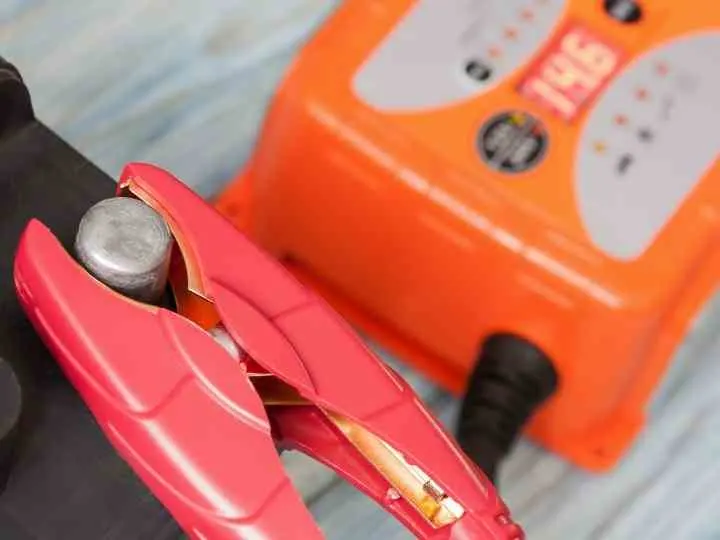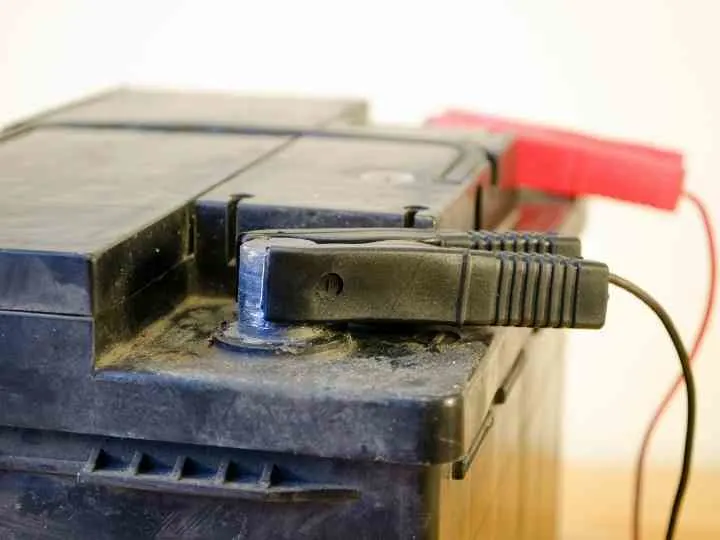A dead battery means you’ll have to jumpstart the car before you’re able to drive.
You can make sure your battery doesn’t die by hooking it up to a charger.
But, is it safe to use a car battery charger?
Most car battery chargers are safe to use. However, you’ve still got to exercise caution if you’re using one of them. They could still create a spark or fire if you’re not careful.
Battery chargers are available in a few varieties. Most of them deliver a trickle charge to maintain a battery’s charge.
Others produce higher voltages to jumpstart dead batteries quickly.
High-voltage chargers are going to carry higher levels of risk. That’s because they’re using a lot more energy to do their jobs, making them riskier.
Safety Precautions to Take When Using a Car Battery Charger
Charging your battery isn’t too dangerous as long as you’re using the charger safely. We’ve gathered some advice to help you use yours without any issues.
Don’t try to use it if you’re in a room that’s not well-ventilated. Batteries produce hydrogen gas as part of their operational cycles.
Most of the time, it’s reabsorbed by the battery as it charges.
However, some of the hydrogen gas could evaporate away from the battery. Putting it in a room without ventilation could cause the gas to build up, creating a safety hazard.
Hydrogen gas is highly volatile, and it doesn’t take much to explode. Even hooking the battery up to a charger could prompt an explosion if there’s no ventilation in the room.
One of the best places to use a charger at home is in the garage. You can even open the garage door, so there’s plenty of airflow.
The next place where people make mistakes is hooking up the battery. There are two terminals on all batteries, one negative and one positive.
The positive terminal usually has a red + symbol somewhere nearby.
You can spot the negative terminal by looking for a black – sign somewhere close to it.
Take a look at your charger to check out its cables. One of them should be red, and the other should be black. You’ve got to hook up the red cable to the red terminal on the battery.
Then, you can hook up the black cable to the black terminal as well.
You always have to use matching colors when you’re working with car batteries. Otherwise, you might short circuit the charging station.
Once you’ve connected the terminals, it’s time to turn on the charger. Most of them have several settings you can use while charging the battery.

These change how many amps the charger produces when it’s on.
The more amps you’re using to charge the battery, the faster it’s going to charge. You can estimate the time it’ll take to reach full capacity by doing a little math.
Each battery has a maximum capacity, usually listed on the label. Let’s say you’ve got a battery that has 600 cold-cranking amps. Your charger is able to deliver 10 amps of electricity when it’s hooked up to it.
You can divide the battery’s capacity by the charger’s amps to see how long charging will take. This example would take 60 hours to reach full capacity if you started at 0 amps.
Using a charger that has higher amps would mean it won’t take as long.
Your battery should also reach full capacity faster if it hasn’t fully discharged.
Grab a voltmeter and use it to monitor the battery’s voltage while it’s charging. It should read 14 V once it’s at full capacity.
Testing the battery with a voltmeter isn’t too difficult, even if you’ve never used one.
Touch the voltmeter’s red diode to the battery’s positive terminal. Then, touch the negative one with the voltmeter’s black diode to complete the circuit.
If you’ve connected them properly, the voltmeter should light up.
Anything less than 10 V isn’t going to be enough to crank your car’s engine, usually. However, a car battery can contain up to 14 V when it’s fully charged.
Can a Car Battery Charger Catch Fire?
The car battery charger can explode if you’re not careful. Charging a battery creates a lot of heat as part of the process. This heat could lead to a fire if the battery is somewhere that’s not well-ventilated.
The battery also releases hydrogen gas whenever it’s discharging.
Hooking it up to a charger might ignite the gas if it’s sufficiently concentrated.
Leaving the battery hooked to a charger for too long increases the odds of fire. You shouldn’t let your battery stay connected to them for longer than 24 hours.
Can Car Battery Chargers Explode?
Actual explosions are rarer than fires, but they’re still possible. The biggest risk when it comes to explosions is hydrogen gas.
You can minimize this by charging the battery in an area that has plenty of airflow.
That’s going to prevent hydrogen buildup, even if the battery releases it.
Always read the directions before using a charger if you’ve never used it before. Each one has different parameters, so it’s important to reach everything.
Make sure you’re following all the directions to reduce the odds of an explosion.

Is It Safe to Leave a Battery Charger on Overnight?
Nowadays, most chargers use smart modules to detect the battery’s voltage. That’s how they’re able to reduce their charging rate once it’s reached capacity.
However, you still shouldn’t leave one hooked up for too long. Leaving one connected to a charger for longer than 24 hours is risky.
Long sessions possess higher levels of risk than short ones by their very nature.
We wouldn’t charge a battery overnight because of the potential risk.
Only charge them if you’re able to keep watch the whole time they’re connected.
Disconnect the battery from the charger by removing the negative terminal as soon as it’s at 14 V or higher.
Is It Safe to Charge a Car Battery in the House?
Never charge a battery inside of the house. They release hydrogen gas whenever you’ve hooked them up to a charger. Leaving them inside your home could lead to hydrogen gas buildup.
A small spark could ignite all the gas, creating a massive explosion.
If you have to charge one at home, do it in the garage. It’ll have much better airflow, helping to prevent gas accumulation.
You could even open the garage door while it’s connected to ventilate the room.
That will stop hydrogen gas from causing you any problems, even if the battery releases tons.
Another way you can prevent gas buildup is by using a small fan to increase air circulation.
The more the air is circulating, the less likely hydrogen gas will build up.
Of course, you should also monitor the battery’s progress as it’s charging, so it doesn’t charge too long.
Remove it from the charge after it’s reached 14 V, as read by a voltmeter. That is enough to use the battery in your car without losing power.
![Are Car Battery Chargers Safe? [Here’s What You Need To Know!]](https://vehicleanswers.com/wp-content/uploads/2022/03/Are-Car-Battery-Chargers-Safe-Heres-What-You-Need-To-Know-720x405.jpg.webp)